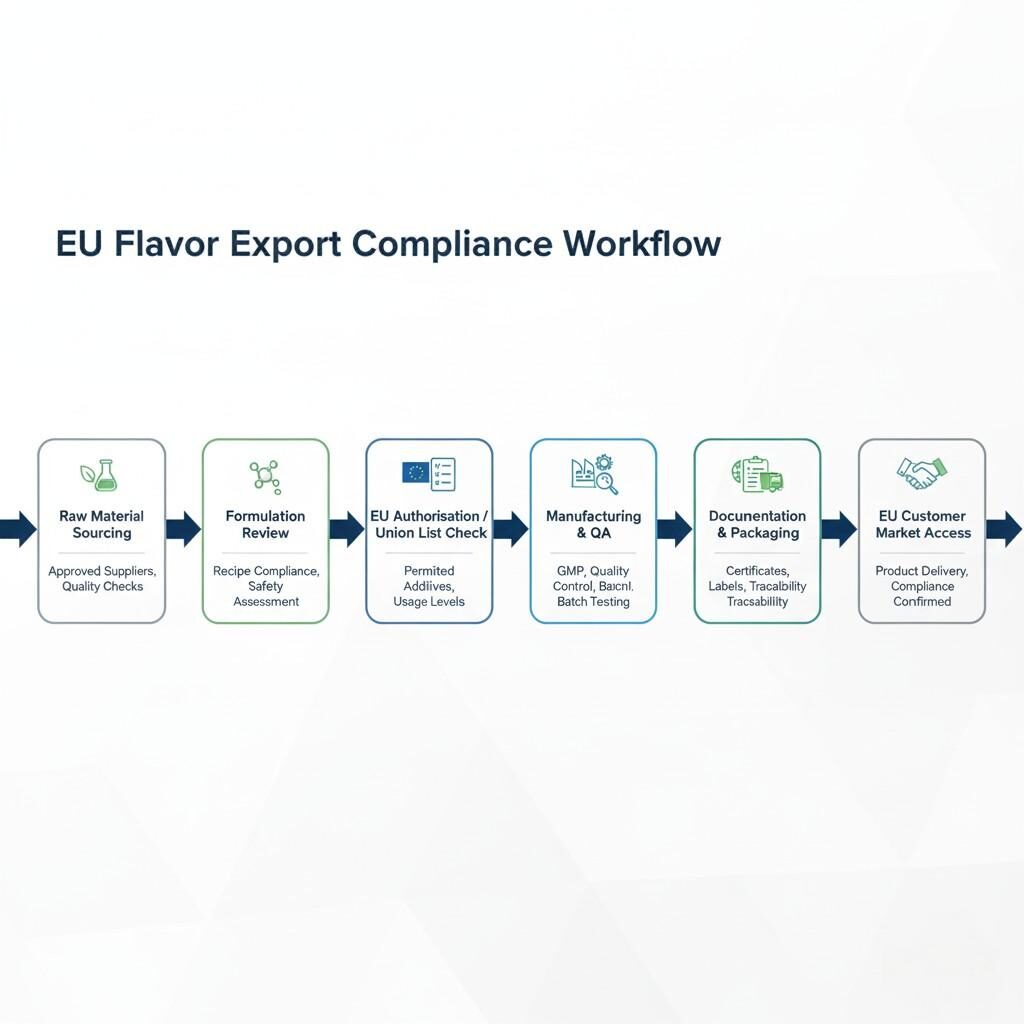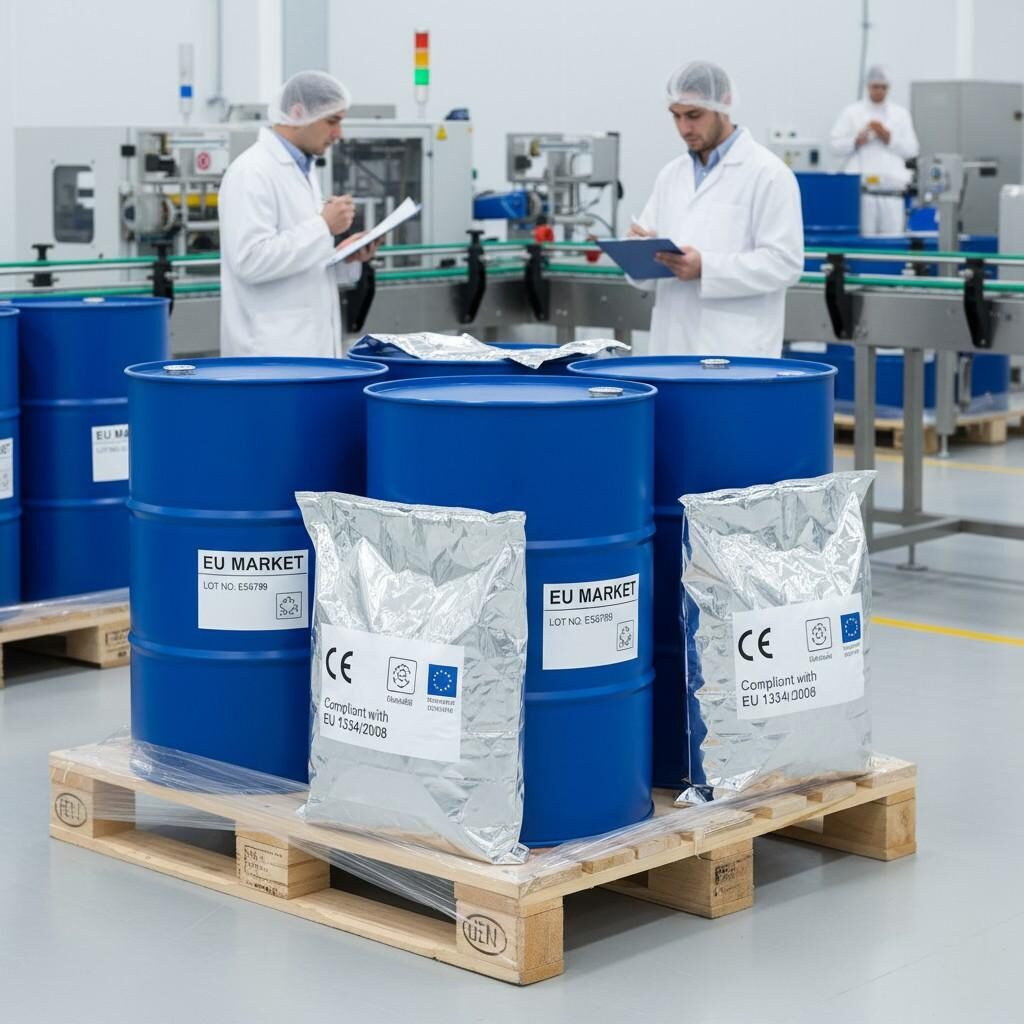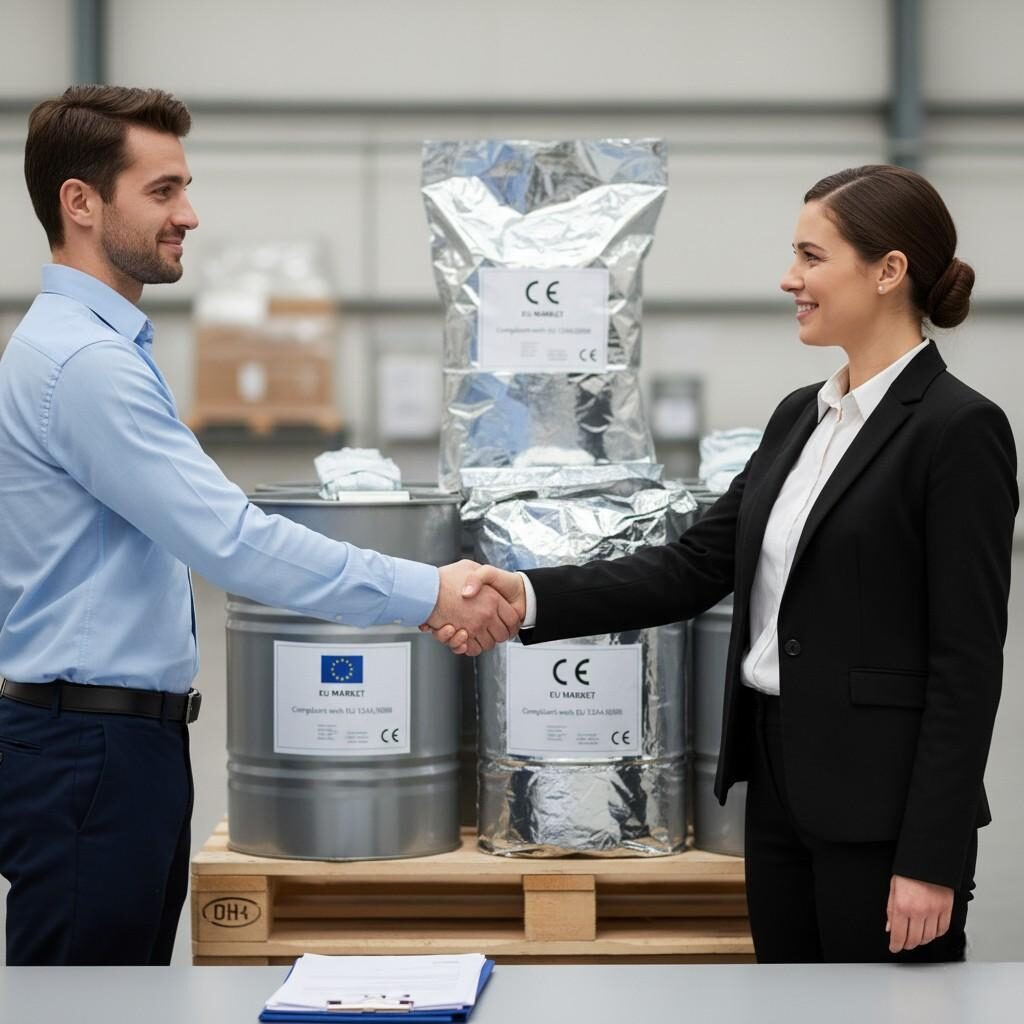作者:Cuiguai调味料研发团队
发表者:广东独特风味有限公司.
上次更新: 十一月 11,2025年

欧盟风味出口准备
介绍
对于旨在将食品和饮料香精出口到欧洲食品安全局 (EU) 市场的香精原料制造商来说,了解并遵守欧盟香精法规不是可有可无的,而是基础。随着欧盟立法对调味品、原材料、标签、安全评估和市场准入进行统一管理,出口商必须相应地调整其配方、文件、制造工艺和供应链。
在这本综合指南中,标题为“了解欧盟风味法规:出口商指南”我们为香料制造商提供量身定制的技术丰富、可操作的信息。我们走过:
- 适用于欧盟香料和香料成分的立法框架。
- (EC) 1334/2008 法规及相关法案规定的主要定义、监管制度和义务。
- 实际合规步骤:档案准备、物质批准、“联合清单”、标签、记录保存。
- 进出口注意事项:海关、采购、供应链文件、非欧盟供应商的风险领域。
- 最佳实践运营集成:质量体系、可追溯性、审核准备、客户沟通。
- 出口商应监控近期的监管更新和风味监管的新趋势。
在这篇文章结束时,您将获得一个结构化的路线图,以调整您的风味产品供应、制造业务和针对欧盟市场的出口文件,从而增强您的信誉并降低监管风险。
1. 欧盟调味品立法框架
1.1 主要法规一览
如果您计划向欧盟出口调味品成分,则适用多项立法,但最主要的一项是关于调味品和某些具有调味特性的食品成分的法规 (EC) No 1334/2008。据欧盟委员会称:
“第 1334/2008 号法规 (EC)……规定了安全使用调味品的一般要求……规定了需要评估和批准的物质。”
其他相关法律文书包括:
- (EC) No 178/2002 号法规(一般食品法)——总体食品安全框架。
- (EC) No 1331/2008 法规 – 食品添加剂、调味剂和酶的通用授权程序。
- (EC) No 1333/2008 号法规 – 食品添加剂法规(相关是因为添加剂可能用于调味品)。
- 具体制度,例如烟熏香料:关于烟熏香料的法规 (EC) No 2065/2003。
1.2 (EC) 1334/2008 法规规定的范围和定义
当您向欧盟出口香料时,了解关键定义至关重要。一些重要的特性:
- 第 3 条将“调味剂”定义为添加到食品中以赋予或改变气味和/或味道的物质。
- 该法规明确适用于食品中使用或拟使用的调味剂、具有调味特性的食品成分、调味剂的原材料以及含有调味剂的食品。
- 它还规定一般条件(第 4 条):仅限调味品不是造成安全风险并做不是可能会误导消费者。
- 它介绍了一个联盟名单批准在欧盟使用的调味物质:法规附件一。只能使用该清单中包含的物质,其他物质必须经过授权。
1.3 调味物质联合清单及近期更新
对于出口商来说,“联盟清单”是最关键的要素之一。根据爱尔兰食品安全局的说法:
“授权在食品中或食品上使用的调味物质的完整清单列于法规 (EC) 1334/2008 的附件 I 中……正在评估的调味物质均标有脚注。”
欧洲风味协会 (EFFA) 强调了该清单的运作方式:
“新法规规定了使用调味剂的一般条件,……已于 2012 年 10 月 2 日制定并发布了经评估和批准的用于食品中和食品上的调味剂和原材料的联合清单。”
最近的监管更新也相关。例如,自 2024 年 1 月起,委员会发布了实施条例 (EU) 2024/238,修订了 1334/2008 附件一,并对某些调味物质引入了限制。
1.4 标签、包装和 B2B 义务
出口商还必须履行香料法规规定的标签和包装义务。例如,该法规规定了向企业客户销售和向消费者销售的调味品的标签规则。在 B2B 层面,调味品的包装必须包含有关过敏原、耐用性以及符合“天然调味物质”定义(如果使用该声明)的详细信息。
2. 实用出口商合规清单:从制定到市场准入
作为希望出口到欧盟的香料供应商,您应该系统地使您的运营符合监管框架。下面是一个实用的清单。

欧盟风味出口工作流程
2.1 配方及原料来源
- 确认您的配方中的每种调味物质均包含在联盟清单(附件一)中或已根据相关程序进行评估/授权。
- 如果您使用新型调味物质或原材料,则必须验证它们是否已获得授权,或根据第 1331/2008 号法规提出申请。
- 收集源材料的完整可追溯性和文档。由于该法规涵盖“调味品和/或具有调味特性的食品成分的原材料”,因此您必须确保您的原材料符合规定(1334/2008 第 2 条)。
- 确保浓缩香料中使用的提取方法和载体系统符合欧盟定义(例如,“天然香料物质”的构成),并且任何声明(例如“天然”)均得到证实。 Sigma-Aldrich 文章指出:
“欧盟第 1334/2008 号法规要求创建一份批准用于食品的风味成分和原材料的‘社区清单’。”
2.2 制造、质量和追溯系统
- 您的生产基地(无论位于欧盟境内还是境外)必须按照记录在案的流程运营,具有从原材料批次到成品香料批次的可追溯性,并且必须支持客户合规性。
- 实施良好生产规范 (GMP)、批次文件、供应商审核、变更控制程序至关重要,尤其是在出口到欧盟药品级或受监管食品成分环境时。
- 根据需要,在成品风味批次包装上贴上正确的批号、生产日期/有效期的标签,并确保您的 B2B 标签符合欧盟标签义务(过敏原、耐用性、声明)。
- 确保您的包装和运输系统防止违规行为(例如,您必须避免将不符合 1334/2008 第 5 条规定的调味品投放到欧盟市场)。
2.3 文件和档案准备
对于出口到欧盟,请确保您至少拥有:
- 所用调味物质的综合清单、CAS 编号、来源材料、使用水平。
- 遵守联盟名单列入或授权的证据。
- 浓缩香料在储存和运输条件下的稳定性数据以及最低耐久性的指示(如果适用)。
- 制造工艺描述,包括提取、载体、加工助剂、包装。
- 标签规范(针对 B2B 供应)和合规声明。
- 欧盟客户的进口文件:提供调味品符合 1334/2008 及相关法规的声明。
- 保留欧盟立法或重新评估的任何更新记录(例如 2024 年限制物质),并在您的风味模块使用任何限制物质时通知客户。
2.4 出口物流和市场准入考虑
- 根据第 178/2002 号法规(《通用食品法》),确认您的欧盟客户(或进口商)在欧盟拥有必要的食品-企业-运营商一致性,并且进口商可以确保前后可追溯性。
- 请注意海关和进口规则:浓缩香料可能根据特定的 HS 代码进行分类;确保正确的原产国声明以及支持调味品分类的文件。
- 监控欧盟法规更新,如果物质受到限制或禁止(例如 2065/2003 规定的烟味香料),则撤回或重新制定风味模块。
- 向您的客户传达欧盟市场上产品的运输包装、储存条件和标签,因为下游使用可能会使您的风味受到欧盟食品企业经营者和当局的审查。
- 维持可召回的追溯系统:根据第 178/2002 号法规,食品经营者必须能够向前一步追溯任何成分和产品。确保您的浓缩香料批次支持可追溯性。
2.5 客户教育和文档移交
- 向您的欧盟客户提供“合规包”,其中包括:符合 1334/2008 法规的声明、调味物质和源材料清单、保质期和存储说明、B2B 标签详细信息。
- 确保“天然香料”或“清洁标签香料”等声明符合欧盟定义(请参阅 1334/2008 和/或 EFFA 指南),并且您可以证实该声明。
- 向客户标记风味模块中的任何变化(原材料来源、制造方法、包装),因为这些变化可能会引发对其成品合规性的重新评估。
- 向客户提供有关在欧盟市场使用调味品时的义务的培训或文件,例如过敏原、标签要求(欧盟法规 1169/2011)。
3. 出口商的案例场景和常见陷阱
3.1 场景:通过非欧盟制造商为欧盟市场提供新风味模块
亚洲的一家香料制造商生产了一种新的基于植物提取物的香料模块,旨在销往欧盟市场。他们必须遵循的关键出口合规步骤包括:
- 验证每种植物来源是否被允许作为 1334/2008 附件 IV 规定的“来源材料”。
- 检查从该植物中提取的调味物质是否包含在联盟列表(附件一)中或申请授权。
- 记录制造工艺、基础油、溶剂、萃取助剂;确保萃取溶剂符合欧盟食品级/溶剂残留限值。
- 为欧盟客户提供合规证书、成分列表、B2B 标签。
- 确保包装上附有正确的批次、耐久性声明、存储说明,并且物流链支持欧盟进口商的可追溯性。
- 关注监管更新(例如 2024 年新限制)并保持灵活性,以便在某种物质被撤回时快速重新配制。例如,烟味禁令表明出口供应可能会突然变得不合规。
3.2 情景:因监管变化而重新制定
假设一家调味品店使用了受实施条例 2024/238(2024 年 1 月)限制的调味物质。他们必须:
- 识别受影响的成品模块并通知客户。
- 使用经批准的调味物质重新配制;如果需要,重新测试稳定性/包装。
- 更新合规包、标签数据、批次文档。
- 监控下游欧盟客户的成品食品以确保合规的连续性。
3.3 常见出口商陷阱
- 使用欧盟清单上未列出的调味物质:未经授权,您不能将该模块出口到欧盟。
- 错误地声称“天然香料”:欧盟在 1334/2008 中定义了“天然香料物质”,只有符合该严格定义的香料才可以使用该术语。
- 标签错误或缺失 B2B 信息:您的包装必须包含正确的信息、耐用性、批号、风味模块的过敏原数据(根据 1334/2008 的标签章节)。
- 忽视包装和储存条件:欧盟监管机构希望香料在确保合规的条件下储存;不良的物流可能会给您的客户带来不合规或降级风险。
- 假设美国/其他非欧盟国家的合规性等于欧盟的合规性:欧盟风味法规在所有成员国之间是一致的——出口商必须将欧盟市场视为一个受监管的集团,而不是依赖旧的国家规则。
- 追溯性差:如果没有批次间的可追溯性,您将面临无法履行欧盟召回义务或客户合规性的风险。根据 178/2002 规定,整个链条都需要可追溯性.
4. 出口香精生产的最佳实践
要成为欧盟的调味品出口商,并被客户视为值得信赖的合作伙伴,您应该采用以下最佳实践:

欧盟出口生产线
4.1 质量管理体系调整
实施符合国际标准(例如 ISO 22000、FSSC 22000)的强大质量管理体系,涵盖原材料采购、制造、可追溯性、文件记录和变更控制。表现出强大系统的出口商往往会更快地获得市场认可。
4.2 综合成分数据库
维护所有调味物质、载体、提取助剂、源材料及其合规状态(联盟列表状态、授权状态、天然香料声明状态、过敏原状态、转基因/非转基因状态、残留溶剂限值)的实时数据库。这使得快速响应客户或监管查询变得更加容易。
4.3 出口包装及物流设计
设计符合欧盟期望的包装、储存和运输条件:阻隔包装、批号、保质期、储存说明、防止降解或污染的运输。如果您供应冷链或受控环境,请向欧盟客户清楚地记录这些条件。
4.4 面向客户的合规包
为欧盟客户准备标准合规包,包括:符合 1334/2008 法规的声明、调味物质和原材料清单、制造工艺摘要、保质期/稳定性摘要、B2B 标签、过敏原声明、转基因/非转基因状态(如果相关)、可追溯性信息。这可以增强信任,缩短客户自身合规的准备时间。
4.5 监测监管变化和主动适应
在您的企业内指派专人(监管事务、出口团队)来监控欧盟委员会网站、EFSA 意见、实施法规(例如 2024 年新限制)和行业贸易协会更新(例如 EFFA)。通过保持领先,您可以避免意外,并可以主动更新配方、订阅和客户沟通。
4.6 审计准备和追溯能力
准备好接受来自认证机构或欧盟客户的审核。您的数据管理系统应该允许您跟踪任何成品批次的风味模块,直至原材料批次、加工记录、包装批次和出口运输。这支持您客户自己的可追溯义务并增强您的出口凭据。
4.7 营销您的合规香料供应商身份
一旦您调整了制造、文件、包装和出口流程,您就应该提升您作为“符合欧盟标准的香料供应商”或“符合欧盟法规的全球香料供应商”的地位。这有助于您在市场中脱颖而出并增强客户信心。
5. 新兴趋势和未来监管观察点
5.1 重新评估和动态联合列表更新
欧盟调味物质清单并不是静态的。出口商必须意识到,欧盟监管机构定期进行重新评估(通过欧洲食品安全局 - EFSA),并可能限制或删除物质。例如,2024 年,委员会通过实施条例 2024/238 对某些调味物质引入了限制。
5.2 天然风味声明和可持续性压力
消费者倾向于“天然”调味品和清洁标签,这意味着监管机构和消费者将更仔细地审查声明。欧盟法规明确了“天然调味物质”和源自原材料的调味制剂的使用。出口商应准备好证实原产地、加工方法和非合成声明。
5.3 烟用香料和潜在的禁令
烟熏香料等特定领域正面临监管压力。欧盟决定禁止八种人造烟味香料是风险管理不断发展的标志。通过识别高风险类别和规划替代方案来保护您的投资组合的出口。
5.4 数字可追溯性和消费者透明度
欧盟政策方向(例如关于透明度的法规 (EU) 2019/1381)强调可追溯性、审计数据访问和监管链。香料出口商应预见到欧盟客户对上游透明度、数字档案、认证状态和审计准备情况日益增长的需求。
5.5 可持续性和供应链道德
虽然主要是食品安全法规,但香料出口商将越来越多地面临客户对可持续采购、公平贸易或无森林砍伐原材料的需求。虽然 1334/2008 没有强制要求,但随着欧盟客户整合 ESG 标准,调整采购和文件有助于保持出口准备状态。
6. 针对出口型香精香料制造商的总结和要点
- 欧盟调味品监管制度既协调又复杂,但对于建立健全合规体系的出口商来说绝对可行。核心法规是法规 (EC) 1334/2008(以及相关法规 1331/2008、1333/2008)。
- 对于香料制造出口商来说,关键的可操作领域是:确保您的香料物质获得授权(联盟清单)、维护完整的文件、确保制造和包装合规、通过合规包装支持您的欧盟客户、设计适合出口条件的包装/物流,并确保可追溯性。
- 质量体系、成分数据库、审核准备情况、出口包装和合规文件不是可选的——它们构成了您进入欧盟的市场准入“门票”。
- 法规更新、不断变化的物质限制、可持续性/可追溯性要求和声明审查(自然、可持续)意味着您必须保持业务的监控和敏捷性。
- 通过将您的公司定位为“符合欧盟标准的香料供应商”,您可以强化对出口到欧盟或在欧盟运营的食品和饮料品牌的价值主张,获得竞争优势并最大限度地降低监管风险。

欧盟市场合作伙伴关系
打电话给行动
如果您准备好将您的风味模块业务拓展至欧盟市场,我们邀请您联系我们的技术和监管团队进行免费咨询和索取合规包样本我们经过风味认证的成分。让我们与您合作,提供完全符合欧盟法规、可追溯、可出口并受到欧盟客户信赖的风味解决方案。
感谢您的阅读。我们鼓励您与您的监管、研发、出口销售和质量团队分享这篇文章,我们可以共同打造合规、有竞争力且面向未来的风味出口产品。
🌐网站:[翠瓜网]
💬Whatsapp:[+86 189 2926 7983]
📩电子邮件:[信息@cuiguai.com]
📞 电话:[+86 0769 8838 0789]



